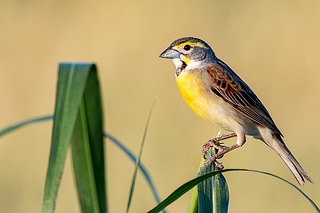
Cardinalidae is a family of New World-endemic passerine birds that consists of cardinals, grosbeaks, and buntings. It also includes several other genera such as the tanager-like Piranga and the warbler-like Granatellus. Membership of this family is not easily defined by a single or even a set of physical characteristics, but instead by molecular work. Among songbirds, they range from average-sized to relatively large, and have stout features, some species with large, heavy bills.
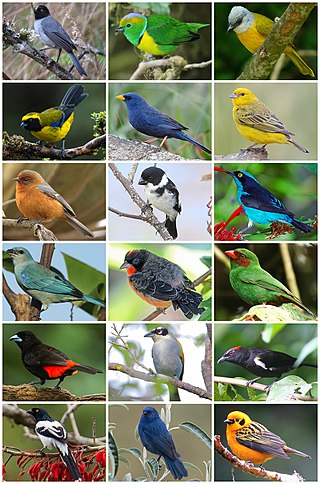
The tanagers comprise the bird family Thraupidae, in the order Passeriformes. The family has a Neotropical distribution and is the second-largest family of birds. It represents about 4% of all avian species and 12% of the Neotropical birds.

Saltator is a genus of passerine birds in the tanager family Thraupidae that are found in Central and South America. They have thick bills, relatively long tails and strong legs and feet. Before the introduction of molecular genetic methods in the 21st century these species were placed in the cardinal family Cardinalidae.

The brown tanager is a small South American bird in the tanager family Thraupidae. It is the only member of the genus Orchesticus.

The tit-like dacnis is a small neotropical passerine bird found in southern Ecuador and Peru. In Spanish, it is known as Azulito Altoandino. It is found in Andean montane scrub forests from 3000 m to 4600 m elevation.

Haplospiza is a small genus of birds in the tanager family Thraupidae. Formerly classified in the bunting and American sparrow family Emberizidae, more recent studies have shown it to belong in the Thraupidae. Its two members breed in subtropical or tropical moist forest in Central and South America. They are often associated with bamboo.

The black-goggled tanager is a species of bird in the family, Thraupidae. It is the only member of the genus Trichothraupis. It is found at low levels in forest and woodland in a large part of eastern and southern Brazil, eastern Paraguay and far north-eastern Argentina, with a disjunct population along the East Andean slope in Peru, Bolivia and far north-western Argentina. While generally common and widespread, and consequently considered to be of least concern by BirdLife International and IUCN, the population associated with the Andes is relatively local and uncommon.

Phrygilus is a genus of mainly Andean seed-eating tanagers commonly known as sierra finches. Phrygilos means finch in Ancient Greek. Traditionally classified in the bunting and American sparrow family Emberizidae, more recent studies have shown them to belong in the Thraupidae.

Poospiza is a genus of finch-like birds in the tanager family Thraupidae that are found in both the South American lowlands and the Andes mountains. Generally they are arboreal feeders in light woodland and scrub. All have extensive grey to their plumage, and have—often bold—white or rufous markings.

Thlypopsis is a genus of birds in the tanager family Thraupidae.

The chestnut-headed tanager is a species of bird in the tanager family Thraupidae this is found in the Atlantic Forest of southeast Brazil, eastern Paraguay and far northeastern Argentina. It was formerly the only member of the genus Pyrrhocoma but is now placed in Thlypopsis.
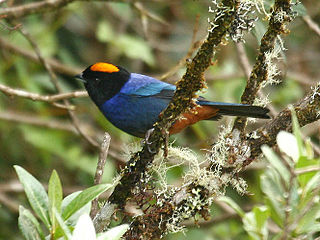
Iridosornis is a genus of Neotropical birds in the tanager family Thraupidae

The blue-black grosbeak is a species of songbird in the family Cardinalidae.

The yellow-shouldered grosbeak is a species of bird in the tanager family Thraupidae. It is the only member of its genus Parkerthraustes. It is found in Bolivia, Brazil, Colombia, Ecuador, and Peru. Its natural habitat is subtropical or tropical moist lowland forests.
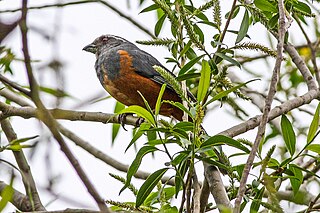
The rufous-bellied mountain tanager or rufous-bellied saltator is a species of songbird in the tanager family Thraupidae and is the only member of the genus Pseudosaltator. It is found in the eastern Andes of southern Bolivia and extreme northern Argentina. It occurs mostly at altitudes from 3000 m to 4000 m. Its habitat is open land, including cultivated land, that has patches of scrub, alder trees, or Polylepis trees. It is threatened by habitat loss.

The blue seedeater, or Cabanis's seedeater, is a species of bird in the cardinal family Cardinalidae that is found in southern Mexico and Central America. The Ecuadorian seedeater was formerly considered as a subspecies.

The blackish-blue seedeater is a species of bird in the family Cardinalidae, the cardinals or cardinal grosbeaks. It is found in Argentina, Brazil, and Paraguay.

Sporophila is a genus of Neotropical birds in the tanager family Thraupidae. The genus now includes the six seed finches that were previously placed in the genus Oryzoborus.

Cnemathraupis is a small genus of mountain tanagers found in forest and woodland in the Andes of South America. The two species are uncommon and relatively large tanagers with a contrasting blue, yellow and black plumage.
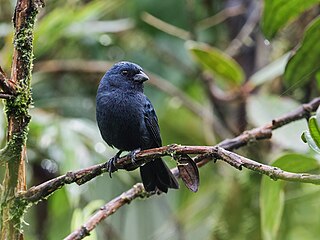
The Ecuadorian seedeater is a species of bird in the cardinal family Cardinalidae that the International Ornithological Committee (IOC) accepted as a species in 2015. It is found in the Andes in southwestern Colombia through Ecuador to northern Peru.



























